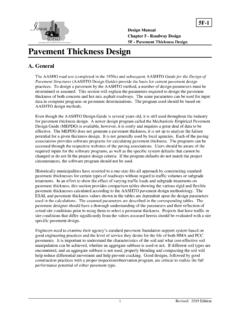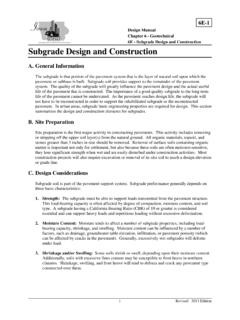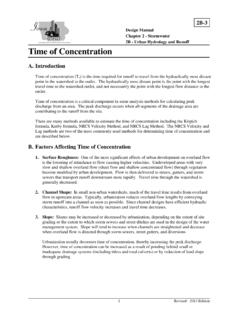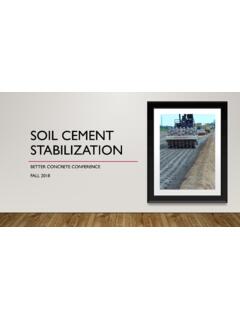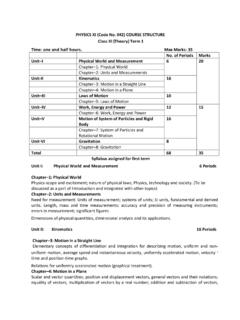Transcription of Section 2E-2 - Culvert Hydraulics
1 2E-2 Design Manual Chapter 2 - Stormwater 2E - Culvert Design Culvert Hydraulics 1 Revised: 2013 Edition A. Culvert Flow Controls and Equations Figure depicts the energy grade line and the hydraulic grade line for full flow in a Culvert barrel. The energy grade line represents the total energy at any point along the Culvert barrel. Headwater is the depth from the inlet invert to the energy grade line. The hydraulic grade line is the depth to which water would rise in the vertical tubes connected to the sides of the Culvert barrel. In full flow, the energy grade line and the hydraulic grade line are parallel straight lines separated by the velocity head lines except in the vicinity of the inlet where the flow passes through a contraction.
2 The headwater and tailwater conditions as well as the entrance, friction , and exit losses are also shown in Figure When equating the total energy at sections 1 and 2 (see Figure ), upstream and downstream of the Culvert barrel in the figure, the following relationship results: HW0+V122g=TW+V122g+H Equation where: H = sum of all losses = + + ; =[1+ +29 2 ] 22 Equation where: V = the average velocity in the Culvert barrel, ft/s g = acceleration of gravity, ft/s ( ) Ke = inlet loss coefficient (see Section 2E-1, Table ) R = hydraulic radius (cross sectional area of the fluid in the Culvert divided by the wetted perimeter) He = entrance head loss =( ) 22 Equation Hf = barrel friction head loss =(29 2 ) 22 Equation Hv = velocity head loss = 22 Equation Chapter 2 - Stormwater Section 2E-2 - Culvert Hydraulics 2 Revised: 2013 Edition Figure : Full Flow Energy and Hydraulic Grade Line Source: Adapted from Hydraulic Design of Highway Culverts, FHWA B.
3 Inlet and Outlet Control The design procedures contained in this Section are for the design of culverts for a constant discharge considering inlet and outlet control. Generally, the hydraulic control in a Culvert will be at the Culvert outlet if the Culvert is operating on a mild slope. Inlet control usually occurs if the Culvert is operating on a steep slope. For inlet control, the entrance characteristics of the Culvert are such that the entrance headlosses are predominant in determining the headwater of the Culvert . The barrel will carry water through the Culvert more efficiently than the water can enter the Culvert . Proper Culvert design and analysis requires checking for inlet and outlet control to determine which will govern particular Culvert designs.
4 For outlet control, the headlosses due to tailwater and barrel friction are predominant in controlling the headwater of the Culvert . The entrance will allow the water to enter the Culvert faster than the backwater effects of the tailwater, and barrel friction will allow it to flow through the Culvert . 1. Inlet Control: Since the control is at the upstream end in inlet control, only the headwater and the inlet configuration affect the Culvert performance. The headwater depth is measured from the invert of the inlet control Section to the surface of the upstream pool. The inlet area is the cross-sectional area of the face of the Culvert . Generally, the inlet face area is the same as the barrel area, but for tapered inlets, the face area is enlarged, and the control Section is at the throat.
5 Examples of inlet control: Figures through depict several different examples of inlet control flow. The type of flow depends on the submergence of the inlet and outlet ends of the Culvert . In all of these examples, the control Section is at the inlet end of the Culvert . Depending on the tailwater, a hydraulic jump may occur downstream of the inlet. Chapter 2 - Stormwater Section 2E-2 - Culvert Hydraulics 3 Revised: 2013 Edition a. Figure depicts a condition where neither the inlet nor the outlet end of the Culvert is submerged. The flow passes through critical depth just downstream of the Culvert entrance and the flow in the barrel is supercritical. The barrel flows partly full over its length, and the flow approaches normal depth at the outlet end.
6 Figure : Inlet/Outlet Unsubmerged Source: Hydraulic Design of Highway Culverts, FHWA b. Figure shows that submergence of the outlet end of the Culvert does not assure outlet control. In this case, the flow just downstream of the inlet is supercritical and a hydraulic jump forms in the Culvert barrel. Figure : Outlet Submerged, Inlet Unsubmerged Source: Hydraulic Design of Highway Culverts, FHWA c. Figure is a more typical design situation. The inlet end is submerged and the outlet end flows freely. Again, the flow is supercritical and the barrel flows partly full over its length. Critical depth is located just downstream of the Culvert entrance, and the flow is approaching normal depth at the downstream end of the Culvert .
7 Figure : Inlet Submerged Source: Hydraulic Design of Highway Culverts, FHWA d. Figure is an unusual condition illustrating the fact that even submergence of both the inlet and the outlet ends of the Culvert does not assure full flow. In this case, a hydraulic jump will form in the barrel. The median inlet provides ventilation of the Culvert barrel. If the barrel were not ventilated, sub-atmospheric pressures could develop which might create an unstable condition during which the barrel would alternate between full flow and partly full flow. Chapter 2 - Stormwater Section 2E-2 - Culvert Hydraulics 4 Revised: 2013 Edition Figure : Inlet/Outlet Submerged Source: Hydraulic Design of Highway Culverts, FHWA 2.
8 Outlet Control: All of the factors influencing the performance of a Culvert inlet control also influence culverts in outlet control. In addition, the barrel characteristics (roughness, area, shape, length, and slope) and the tailwater elevation affect Culvert performance in outlet control. The barrel roughness is a function of the material used to fabricate the barrel. Typical materials include concrete and corrugated metal. The roughness is represented by a hydraulic resistance coefficient such as the Manning n value. The barrel area and barrel shape are self-explanatory. The barrel length is the total Culvert length from the entrance to the exit of the Culvert . Because the design height of the barrel and the slope influence the actual length, an approximation of the barrel length is usually necessary to begin the design process.
9 The barrel slope is the actual slope of the Culvert barrel. The barrel slope is often the same as the natural stream slope. However, when the Culvert inlet is raised or lowered, the barrel slope is different from the stream slope. The tailwater elevation is based on the downstream water surface elevation. Backwater calculations from a downstream control, a normal depth approximation, or field observations are used to define tailwater elevation. Hydraulics of outlet control: Full flow in the Culvert barrel, as depicted in Figure , is the best type of flow for describing outlet control Hydraulics . Outlet control flow conditions can be calculated based on energy balance. The total energy (HL) required to pass the flow through the Culvert barrel is made up of the entrance loss (He), the friction loss through the barrel (Hf), and the exit loss (Ho).
10 Other losses, including bend losses (Hb), losses at junctions (Hj), and losses at gates (Hg) should be included as appropriate. a. Figure represents the classic full flow condition, with both inlet and outlet submerged. The barrel is in pressure flow throughout its length. This condition is often assumed in calculations, but seldom actually exists. Figure : Inlet/Outlet Submerged Source: Hydraulic Design of Highway Culverts, FHWA Chapter 2 - Stormwater Section 2E-2 - Culvert Hydraulics 5 Revised: 2013 Edition b. Figure depicts the outlet submerged with the inlet unsubmerged. For this case, the headwater is shallow so that the inlet crown is exposed as the flow contracts to the Culvert .
